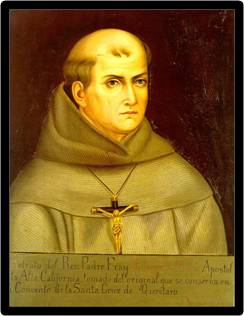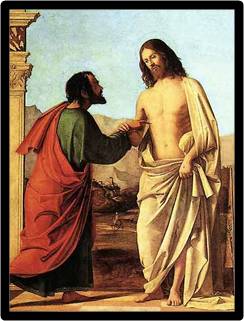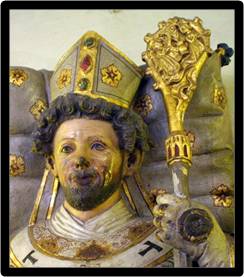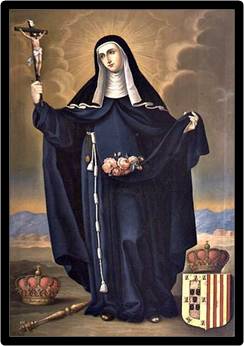JULY 1 - BLESSED JUNIPERO SERRA

Miguel Jose Serra was born in Petra, Spain. When he was fifteen, he became a student at the Franciscan school in Palma, twenty-five miles away. He then joined the Franciscan order a few months before his seventeenth birthday taking the name Junipero after the friend of St. Francis.
During his training to become a priest, Junipero read the life stories of Franciscan saints. The saint whose life fascinated him most was St. Francis Solano, a missionary priest to South America who had been declared a saint just a few years earlier. Young Junipero decided that, if it was God’s will, he too would be a missionary.
Junipero was ordained a priest in 1736 and became a professor of philosophy. Twenty years, later, he was given the wonderful opportunity to go as a missionary to a place called “New Spain” in Mexico and California.
Junipero and his close friend, Friar Francisco Palou, joined the group of missionaries at a seaport city in Spain called Cadiz. From there they sailed across the Atlantic Ocean to Vera Cruz, Mexico and arrived there on December 6, 1749.
Soon after they landed, Junipero got bitten by a mosquito that left one leg swollen. He also suffered from asthma (making it difficult to breathe at times). This made walking a painful process for the rest of his life. But he and another friar walked the next part of the journey from Vera Cruz to Mexico City, a distance of 240 miles which took them more than fifteen days.
From Mexico City, Junipero and Friar Francisco Palou were sent to work among the Pame Indians (a tribe of Red Indians) at the Franciscan Mission of the Sierra Gorda. Several of the friars then traveled to missions in Lower California. Junipero, Francisco and a handful of other Franciscans were asked to bring the Gospel to the native peoples in Upper California.
Junipero started Mission San Diego on July 16, 1769, when he was fifty-six years old. The mission was an open invitation to his beloved people to come and meet Jesus who slowly began to trust the friars. Some people were baptized and began to live the Christian faith. Father Serra and the friars loved and protected their people. They trained many of them in European methods of agriculture, cattle husbandry, and othe crafts.
Then the golden chain of new missions grew: Mission San Carlos in Monterey; Mission San Antonio de Padua; Mission San Gabriel Archangel; Mission San Luis Obispo; Mission San Francisco de Asis; Mission San Juan Capistrano; Mission Santa Clara de Asis; Mission San Buenaventura.
He founded twenty-one missions and finally, six thousand native peoples were baptized and became followers of Jesus. Junipero helped the Church to grow on the west coast of the United States.
Blessed Junipero made his final tour of the missions in Upper California which lasted about six months. He died peacefully at Mission San Carlos on August 28, 1784, and is buried there. In 1988, Pope John Paul II declared Father Junipero Serra “blessed.”



